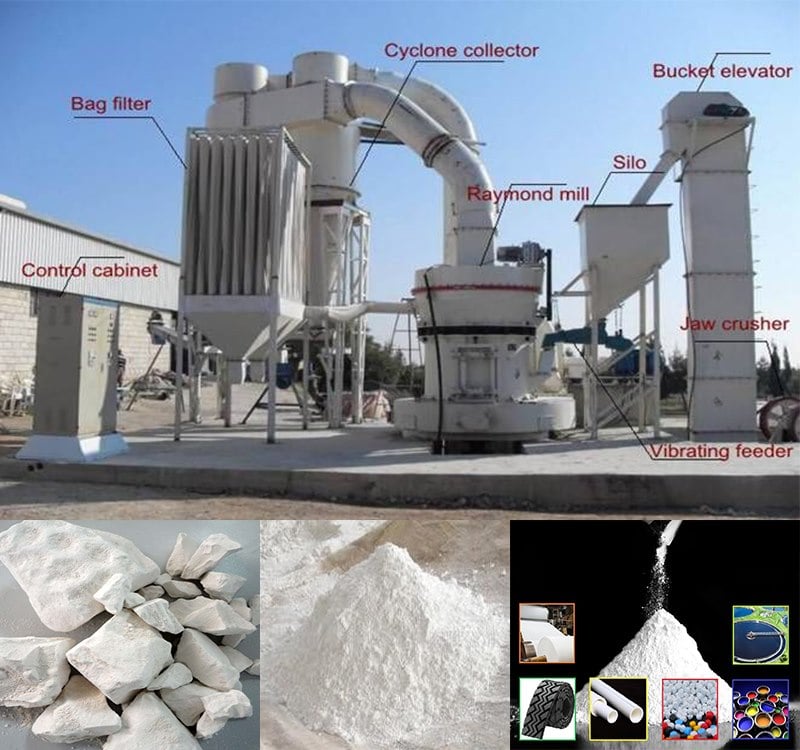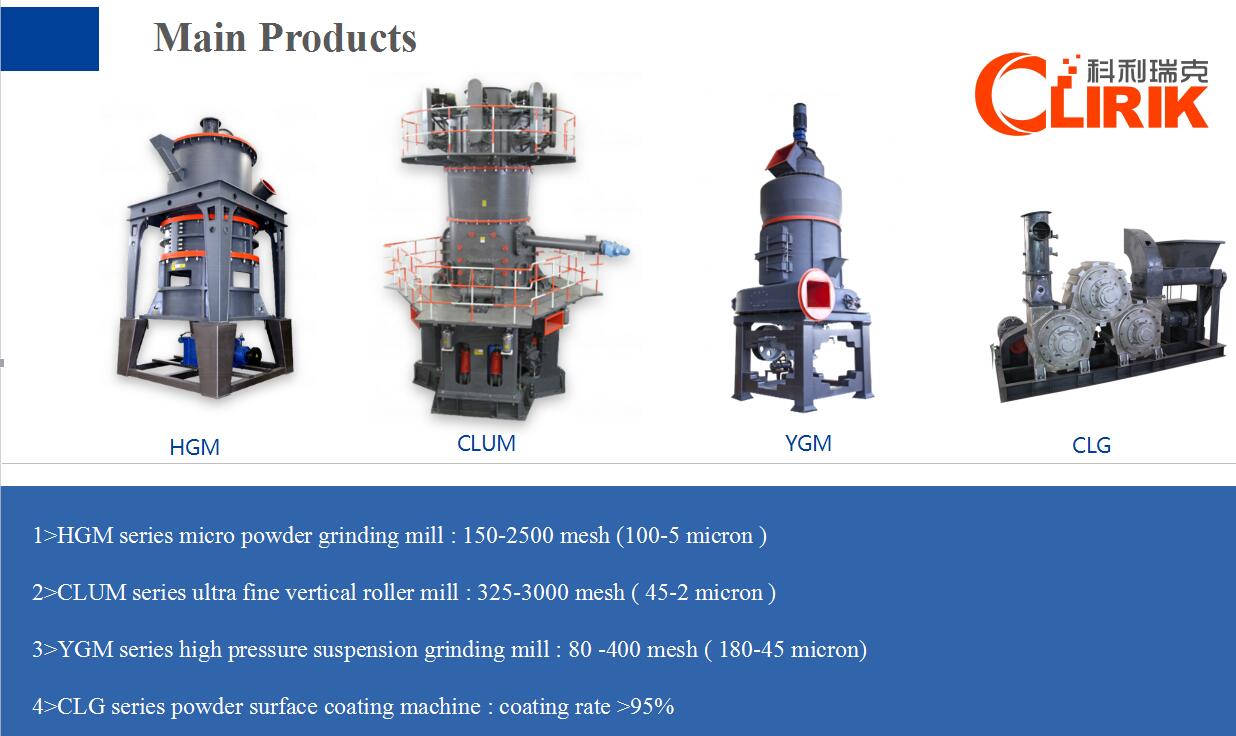News
1-10 t/h Grinding Raymond Mill
Date:2023-11-20 17:21:17
im
Raymond Mill is a commonly used industrial milling equipment, primarily used for barite, calcite, potash feldspar, talc, marble, limestone, dolomite, fluorite, lime, activated clay, activated carbon, bentonite, kaolin, cement, phosphate ore, gypsum, glass, insulation materials, etc.

The capacity of a Raymond Mill is often expressed in terms of tons per hour. However, the actual capacity depends on various factors, including the material being processed, the fineness of the finished product, the humidity of the material, and the type of grinding mill.
Here are some general considerations:
1. Material Hardness: Harder materials often require more grinding time and energy.
2. Fineness Requirements: Finer grinding requires more time and may reduce the throughput.
3. Humidity of Material: Wet materials can be more challenging to grind efficiently.
4. Mill Configuration: The design and configuration of the Raymond Mill can affect its performance.
5. Grinding Media: The type and size of grinding media used in the mill can impact the grinding process.
6. Maintenance: Regular maintenance is essential for optimal performance.
Without specific details about the material and the operational conditions, it's challenging to provide more precise information. If you have specific requirements or a particular application in mind, it's advisable to consult with the manufacturer or a qualified engineer to determine the most suitable mill and its expected capacity for your needs.
What Issues Should Consider When Choosing A Raymond Mill?
Here are some additional considerations and information related to Raymond Mills and their operation:
1. Power Consumption:
The power consumption of the Raymond Mill is an important factor to consider. Higher capacities and finer grinding generally require more power.
2. Airflow and Ventilation:
Proper airflow through the mill is crucial for efficient grinding. The ventilation system helps control the temperature inside the mill and ensures the proper transport of the finished product.
3. Feed Size:
The size of the feed material entering the mill can affect its efficiency. Larger particles may require more energy to grind, and the feed size distribution can impact the final product's fineness.
4. Wear and Maintenance:
Parts of the Raymond Mill, such as grinding rolls, grinding rings, and the blade system, may wear over time. Regular inspection and maintenance are necessary to ensure optimal performance and longevity.
5. Particle Size Distribution:
The desired particle size distribution of the final product is a critical factor in the selection of a grinding mill. Different mills may be better suited for specific particle size requirements.
6. Control System:
Modern Raymond Mills often come equipped with advanced control systems that allow operators to adjust parameters such as grinding pressure, rotation speed, and airflow, optimizing performance.
7. Environmental Considerations:
Dust collection systems and other environmental controls are important for maintaining a clean and safe working environment.
8. Testing and Trials:
Before committing to a specific mill for a large-scale operation, it's common to conduct testing and trials to ensure that the mill meets the desired performance criteria.
9. Manufacturer's Guidelines:
Always follow the manufacturer's guidelines and recommendations for operation, maintenance, and safety.
If you have specific technical requirements or if you're considering the purchase of a Raymond Mill for a particular application, it's recommended to consult with the manufacturer or a knowledgeable engineer who can provide tailored advice based on your needs. Additionally, consider obtaining quotes and information from multiple suppliers to compare features and capabilities.
Raymond Mill Types
Raymond mills come in several types, each with unique features and applications. Here are some common types of Raymond mills:
l Raymond Roller Mill: This is the most common type. The grinding rollers crush the material against the grinding ring. The crushed material is carried by the airflow through the mill to the cyclone separator and then collected in a bag filter. The airflow helps to classify the material and control the product's fineness.
l Raymond Ball Mill: Combining the functions of a Raymond mill and a ball mill, this type offers more efficient grinding performance. It operates by rotating a cylinder with steel grinding balls, causing the balls to fall back into the cylinder and onto the material to be ground.
l Raymond Imp Mill: This mill system uses a centrifugal force-based classification system for fine and coarse particle separation. It is particularly suitable for pulverizing materials with low melting points and high fat content.
l Raymond Vertical Mill: This type of mill operates on the same principles as the traditional Raymond Roller Mill but has a vertical grinding chamber. This design allows for a more compact footprint, making it suitable for smaller installations.
l Raymond Ultrafine Mill: Designed for extremely fine or coarse grinding of materials, this type of mill is equipped with an adjustable dynamic classifier that can be used to control product fineness.
l Raymond Flash Dryer: While not a traditional grinding mill, the Raymond Flash Dryer is used for drying and grinding materials simultaneously. It typically combines drying and pulverizing in the same operation.
The choice of the specific type of Raymond mill depends on factors such as the material to be processed, desired product fineness, moisture content, and overall system requirements. It's essential to consult with the manufacturer or a qualified engineer to select the most suitable type of Raymond mill for a particular application. Additionally, advancements in technology may lead to the development of new types of Raymond mills in the future.
Raymond Mill Roller Types
Raymond mills typically utilize grinding rollers or grinding rolls to crush and grind various materials. The configuration and design of the grinding rollers can vary, and the choice of roller type can impact the efficiency and performance of the Raymond mill. Here are some common types of grinding rollers used in Raymond mills:
l Bowl/Gravity Style Rollers: In this design, the grinding rolls are stationary, and the grinding ring rotates around them. The material is fed from the top and is crushed between the rotating grinding ring and the stationary grinding rolls.
l Pendulum Style Rollers: This type of roller assembly swings outward against the grinding ring, providing a more even and efficient grinding action. The pendulum style is commonly used in larger mills.
l Centrifugal Style Rollers: These rollers operate on the principle of centrifugal force. They are typically mounted on a rotating shaft, and the material is fed through a central chute. The centrifugal force throws the material against the grinding ring, facilitating the grinding process.
l Three / Four / Five Roller Mill: Depending on the specific design, Raymond mills can have three, four, or even five grinding rollers. The additional rollers allow for increased grinding capacity and efficiency.
l High-Pressure Grinding Rolls (HPGR): While not exclusive to Raymond mills, some advanced models incorporate high-pressure grinding rolls. HPGR technology involves the use of two counter-rotating rolls, often with a specific pattern on the roll surface to create a high-pressure nip zone. This can be effective for reducing energy consumption and increasing throughput.
The choice of roller type depends on factors such as the material characteristics, desired product fineness, and capacity requirements. Manufacturers may offer different roller configurations based on these factors.
When considering a Raymond mill, it's essential to review the manufacturer's specifications and recommendations regarding the roller type and design. Additionally, advancements in technology may lead to the development of new roller types or improvements in existing designs. If you have specific requirements or if you're considering a Raymond mill for a particular application, consulting with the manufacturer or a qualified engineer is advisable.



